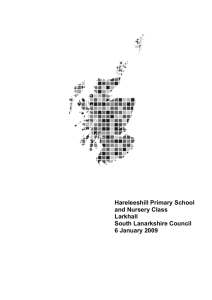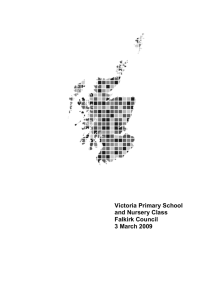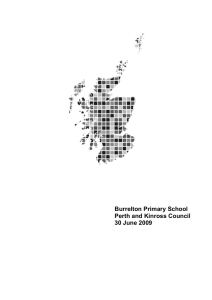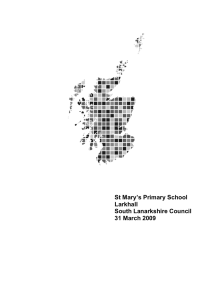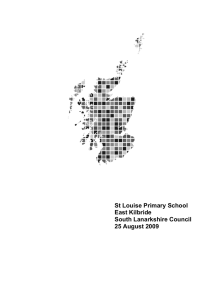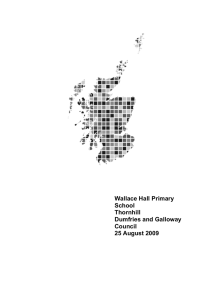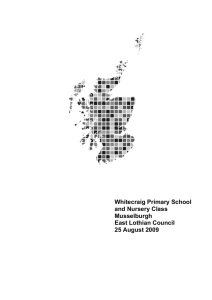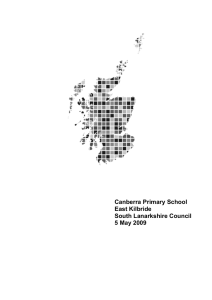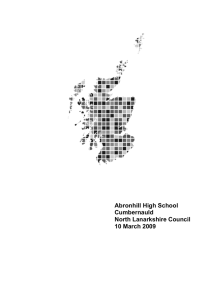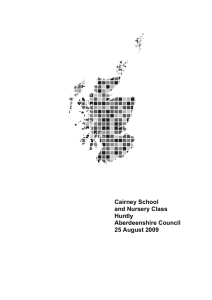Nesting Primary School Shetland Islands Council 2 June 2009
advertisement
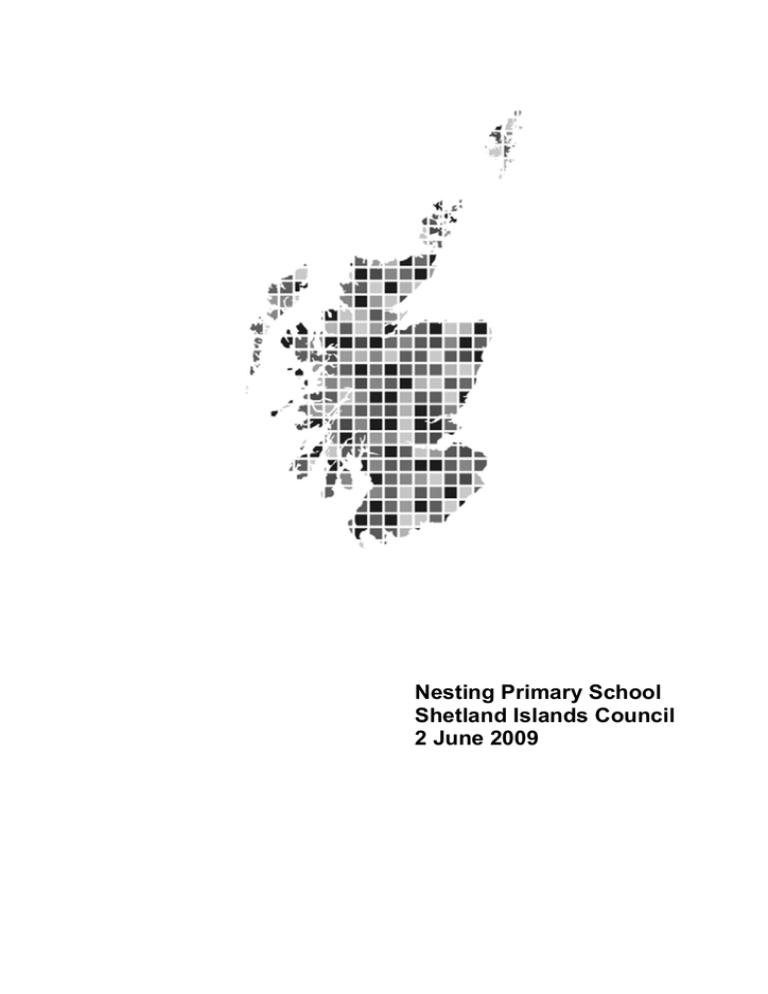
Nesting Primary School Shetland Islands Council 2 June 2009 This report tells you about the quality of education at the school1. We describe how children benefit from learning there. We explain how well they are doing and how good the school is at helping them to learn. Then we look at the ways in which the school does this. We describe how well the school works with other groups in the community, including parents2 and services which support children. We also comment on how well staff and children work together and how they go about improving the school. Our report describes the ‘ethos’ of the school. By ‘ethos’ we mean the relationships in the school, how well children are cared for and treated and how much is expected of them in all aspects of school life. Finally, we comment on the school’s aims. In particular, we focus on how well the aims help staff to deliver high quality learning, and the impact of leadership on the school’s success in achieving these aims. If you would like to learn more about our inspection of the school, please visit www.hmie.gov.uk. Here you can find analyses of questionnaire returns. Where applicable, you will also be able to find descriptions of good practice in the school. 1 2 The term ‘school’ is used to include the work of the nursery class, where relevant. Throughout this report, the term ‘parents’ should be taken to include foster carers, residential care staff and carers who are relatives or friends. Contents 1. The school 2. Particular strengths of the school 3. Examples of good practice 4. How well do children learn and achieve? 5. How well do staff work with others to support children’s learning? 6. Are staff and children actively involved in improving their school community? 7. Does the school have high expectations of all children? 8. Does the school have a clear sense of direction? 9. What happens next? 1. The school Nesting Primary School is a non-denominational school. It serves the communities of North and South Nesting. The roll was 23 when the inspection was carried out in March 2009. Pupils’ attendance was in line with the national average in 2007/2008. 1 2. Particular strengths of the school • The role of all staff in providing a range of opportunities for children to achieve widely. • The use of information and communications technology to enhance children’s learning. • Productive partnerships with parents, local schools and the community to enhance children’s learning. • The success of the school in developing children’s knowledge and understanding of local culture. 3. Examples of good practice • Singing in Shetland dialect. • Use of information and communications technology. 4. How well do children learn and achieve? Learning and achievement Children are proud of their school and share their views confidently. They are developing their understanding of the heritage of Shetland by taking part in community events, including ‘Up-Helly-Aa’. Children have very good opportunities to achieve more widely through a range of after-school activities, such as, cookery, woodwork and sports. They have positive attitudes towards the environment and have 2 achieved two Eco-Schools Scotland green flags. Children are skilled at singing in Shetland dialect and playing musical instruments and successfully take part in school and community performances. They use information and communications technology (ICT) effectively to talk and share learning experiences with children from schools in London. At P6 and P7, children developed their confidence and social skills through participating in a residential trip to London along with another local primary school. Children are making good progress in listening and talking, reading and mathematics. They are making satisfactory progress in writing. Children listen well and are able to express their ideas clearly. Staff now need to develop children’s skills in listening and talking to each other in groups. Children enjoy reading and use the library regularly to select books by their favourite authors. They speak enthusiastically about books they have read. Children write for a variety of purposes, including poetry. They are developing their use of vocabulary to add detail to their writing. However, children do not always write well consistently. Children are beginning to use their literacy skills in other areas of the curriculum. In mathematics, they have an appropriate understanding of number, money and measurement. They are confident in recognising the properties of two- and three-dimensional shapes. At the upper stages, children are able to discuss and use problem solving strategies. Across the school, children’s skills in mental calculations need to be further developed. Curriculum and meeting learning needs Staff provide children with a broad curriculum. They are developing aspects of the national initiative, Curriculum for Excellence. For example, they plan activities which encourage children to link their learning in different areas of the curriculum. Staff encourage children to be creative, particularly in music and art. They use the local area very well to develop children’s knowledge and understanding of the environment. They have increased children’s enjoyment in the curriculum by providing opportunities for children to select the focus of their learning in environmental studies topics. Children enjoy developing their skills in enterprise and are using their skills to organise a talent show. They are increasing their understanding of the 3 world of work. The school is working towards providing two hours of physical education each week for children. Classroom tasks and activities are not always well enough matched to meet the needs of all children. For some children, the pace of learning is too slow and they need to be given more challenging work. The school has appropriate procedures for identifying those children with additional support needs. Children who have difficulties with aspects of their learning have individualised plans in place. These plans help children with additional support needs to make progress in their learning. Teachers give clear explanations and instructions and share the purpose of lessons with children. They use questioning well to check children’s understanding. Children are capable of completing tasks without close supervision. They do not always know how well they are doing and how to improve their work. Teachers set a broad range of interesting homework tasks. 5. How well do staff work with others to support children’s learning? Staff work with a range of people to support children’s learning. These include staff from speech and language therapy, health agencies and psychological services. Volunteers from the local community help with after-school activities, including woodwork. Parents of children with additional support needs are involved in reviewing the progress their child has made towards individual learning targets. Support staff make positive contributions to supporting children’s learning. The school works closely with the supportive Parent Council. Parents are kept well informed about the work of the school through regular newsletters and the school website. Termly class information leaflets provide parents with helpful information about key aspects of children’s classwork. While most parents are happy with the work of the school a few do not feel their concerns are dealt with appropriately. The school has appropriate programmes in place for children moving into P1 and for P7 pupils transferring to Scalloway Junior High School. 4 6. Are staff and children actively involved in improving their school community? Children are actively involved in improving the school. They have a range of opportunities to take on roles of responsibility and contribute to the life of the school, including as part of the pupil council and eco committee. Children have a good understanding of healthy lifestyles and the school has gained Health Promoting School status. Children have worked with parents and members of the community to improve the school grounds. The school gathers the views of staff, parents and pupils and has used them to improve the work of the school. For example, in response to parental questionnaires, the school has improved homework and further developed links with other local schools. Children’s views have been taken into account to increase musical tuition and extend the range of after-school activities. Staff discuss issues relating to teaching and learning and are committed to improving the work of the school. The school has improved approaches to monitoring children’s experiences and tracking their progress. This has not yet had sufficient impact on raising attainment and ensuring all children make appropriate progress. 7. Does the school have high expectations of all children? The school is welcoming and has a positive atmosphere. Children are friendly and engage readily with visitors. They have very positive relationships with all staff. Children feel the school treats them fairly and their opinions are listened to and valued. They know what to do if they are concerned about anything. Staff have received training in child protection and they know what to do if the headteacher is not in school. The school has formed productive links with other schools in the local area and in London. Appropriate procedures are in place to encourage and monitor children’s attendance at school. Staff do not yet have high enough expectations of what children can achieve. The school is aware of the need to review its policy for dealing with any instances of bullying behaviour. Children’s achievements are celebrated through assemblies, a golden folder and local newspapers. 5 The local minister supports the work of the school. There are regular opportunities for religious observance. Children learn about other cultures and beliefs well through the programme for religious and moral education and speaking with children of different faiths. 8. Does the school have a clear sense of direction? The headteacher has a clear vision for the school. She has involved staff, parents and children fully in agreeing an appropriate set of aims. She is highly committed to the school community and to improving the work of the school. She has led the staff on improving important aspects such as forward planning and the use of ICT. Staff work well together as a team. The headteacher has improved approaches to monitoring and evaluating the work of the school. Together with the staff, she needs to use the information gathered to more rigorously evaluate the impact on children’s learning. The school is well placed to improve further. 9. What happens next? We are confident that the school will be able to make the necessary improvements in light of the inspection findings. As a result, we will make no more visits following this inspection. The school and the education authority will inform parents about the school’s progress in improving the quality of education. 6 We have agreed the following areas for improvement with the school and education authority. • Ensure the pace of learning and level of challenge are sufficient to meet the needs of all pupils. • Continue to develop approaches to monitoring and evaluating the work of the school to improve children’s experiences and attainment. 7 Quality indicators help schools and nursery classes, education authorities and inspectors to judge what is good and what needs to be improved in the work of a school and a nursery class. You can find these quality indicators in the HMIE publications How good is our school? and The Child at the Centre. Following the inspection of each school, the Scottish Government gathers evaluations of three important quality indicators to keep track of how well all Scottish schools and nursery classes are doing. Here are the evaluations for Nesting Primary School. Improvements in performance Learners’ experiences Meeting learning needs good good satisfactory We also evaluated the following aspects of the work of the school. The curriculum Improvement through self-evaluation HM Inspector: Janie McManus 2 June 2009 8 good satisfactory To find out more about inspections or get an electronic copy of this report go to www.hmie.gov.uk. Please contact the Business Management and Communications Team (BMCT) if you wish to enquire about our arrangements for translated or other appropriate versions. If you wish to comment about any of our inspections, contact us at HMIEenquiries@hmie.gsi.gov.uk or alternatively you should write in the first instance to BMCT, HM Inspectorate of Education, Denholm House, Almondvale Business Park, Almondvale Way, Livingston EH54 6GA. Our complaints procedure is available from our website www.hmie.gov.uk or alternatively you can write to our Complaints Manager, at the address above or by telephoning 01506 600259. If you are not satisfied with the action we have taken at the end of our complaints procedure, you can raise your complaint with the Scottish Public Services Ombudsman (SPSO). The SPSO is fully independent and has powers to investigate complaints about Government departments and agencies. You should write to SPSO, Freepost EH641, Edinburgh EH3 0BR. You can also telephone 0800 377 7330, fax 0800 377 7331 or e-mail: ask@spso.org.uk. More information about the Ombudsman’s office can be obtained from the website at www.spso.org.uk. This report uses the following word scale to make clear judgements made by inspectors. excellent very good good satisfactory weak unsatisfactory outstanding, sector leading major strengths important strengths with some areas for improvement strengths just outweigh weaknesses important weaknesses major weaknesses Crown Copyright 2009 HM Inspectorate of Education
